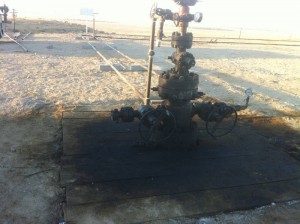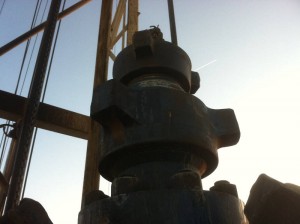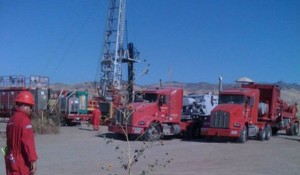(Referred from What are Frack Hits)
Frac Hit: Cross-well communication initiated while pumping a hydraulic fracturing treatment.
While pumping a frac job, an offset well may become charged with pressure or sanded-in from injected frac fluids. This well has been given a frac hit due to pressure communication. If frac sand actually enters the offset well then it is also considered a frac’ed into well.
 Severity Levels
Severity Levels
- Pressure communication: For two wells to communicate, the injected frac fluids do not need to actually reach the observing well. Pressure communication only requires pressure waves governed by the diffusivity equation to propagate through the reservoir space.
- Sanded in (Frac’ed into): When fractures themselves actually propagate to the producing well then the frac fluids and sand will transmit into the producing well. This can cause damage to the completion and lift equipment.
- Loss of well control: Hydraulic fracturing is done under high rates and pressure, which requires robust well control equipment on the injecting well. When this pressure is transferred to wells that have less pressure integrity, a failure of pressure control can occur. This can cause a blowout of either frac fluids or charged reservoir fluids.
 Factors to consider:
Factors to consider:
 Anisotropy: This term refers to the preferential permeability in one direction over the other. Similarly, there may be complex permeability channels within the reservoir. The propagation of pressure transient waves moves faster with respect to higher permeability.
Anisotropy: This term refers to the preferential permeability in one direction over the other. Similarly, there may be complex permeability channels within the reservoir. The propagation of pressure transient waves moves faster with respect to higher permeability.
Depletion: When a producer has drawn down a large volume of reservoir fluids it can create a cone of pressure depletion. This reduced pressure attracts influxes from flows that are injected in elsewhere according to Darcy’s equation. The other issue with pressure depletion is that the fracture pressure will also decrease the fracture pressure of the depleted area around the producer.
Offset Distance: Producing wells that are closer to the injecting well are obviously at a higher risk for communication.
Permeability: In general, higher permeability allows pressure waves to propagate more quickly through the reservoir. It also allows fluids to disperse or “leak off” more quickly from a fracture so permeability effects in the reservoir will have complex interactions on cross well communications.
Stress Regime: The stress orientation within the reservoir will dictate which direction the fractures will orient themselves. This orientation will change over time when reservoir pressure changes through refracturing and pressure depletion. This contributes to frac hits when the stress regime causes the fracture orientation to be directed straightaway from the treatment well to the producing well.
Release Hazards:
Hydrogen Sulfide: If the reservoir contains H2S and pressure communication causes a release at an offset well then a release of H2S must be expected.
Flammable Fluids: Offset well releases will release reservoir fluids, which tend to be extremely flammable.
Lift Equipment Damage: The influx of sand into a producer will damage the lift equipment. If the lift equipment is running, this can cause severe damage.
Shut Down: Frac jobs are complicated and expensive undertakings. When a frac hit communicates with a nearby offset and causes a release this can endanger the job.
Well Control: A release of fluids is never the least of concerns during a frac treatment. Offset wells from the frac injector will likely be capped by a lower rating wellhead and possibly with a lubricator.
 Mitigating Techniques:
Mitigating Techniques:
Micro-seismic: Micro-seismic is a mapping technique that measures fracturing events in the reservoir during a frac job. This helps understand the fracture direction in future fracture stimulations.
Shut-in Offsets: If planned properly, offset producers can be shut-in before the frac job to allow reservoir pressure to build up around the producer. This is the most important operational choice for preventing damage to producers from frac hits.
Need to train your frac professionals? Call Eagle Ford Training at 210-802-4026
Recommended Training: Frac School, H2S Training, SafeLand Training
Notice: Article is provided as is and for informational use only. Eagle Ford Training San Antonio, its owners, instructors, and affiliates hereto referred as the company shall have no liability for and you shall defend, indemnify and hold harmless from and against any claim loss demand, liability, obligation, and expense based upon any injury or damage, spill or pollution, product liability, or any other loss that may occur. The liability for the use of information is solely yours notwithstanding any act of error or omission by the company.
This article is provided for informational purposes only in the public interest of hydrogen sulfide, oil and gas safety, and well control. Any references to third parties are ancillary to the goal of promoting those public interests. Eagle Ford Training San Antonio is a Texas corporation and does business exclusively within the State of Texas. Texas statute provides comprehensive relief against Strategic Lawsuits Against Public Participation.
